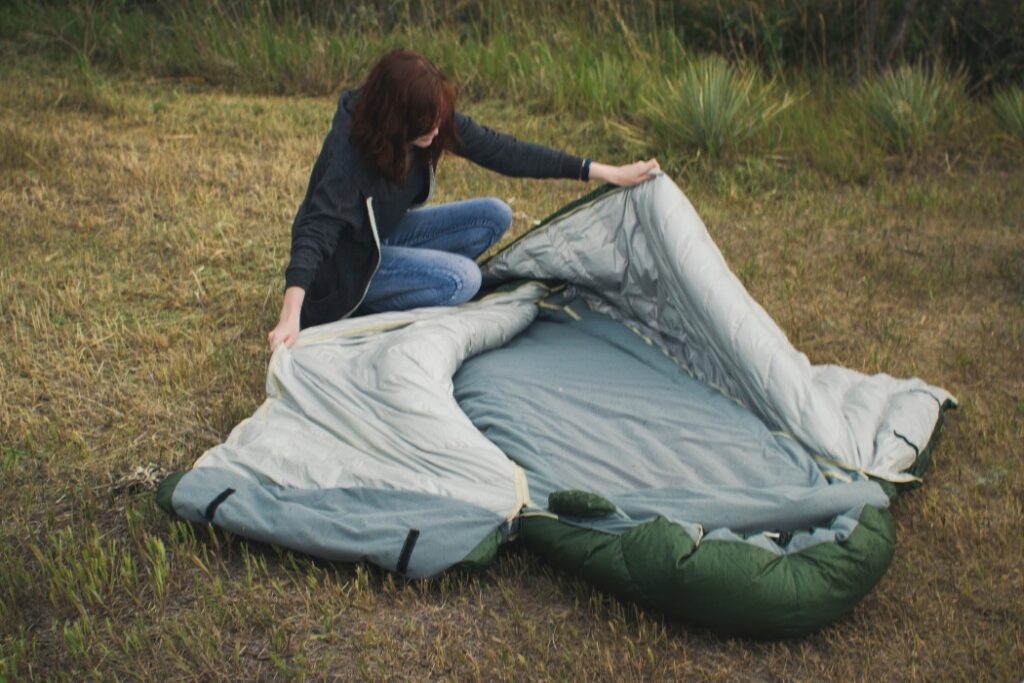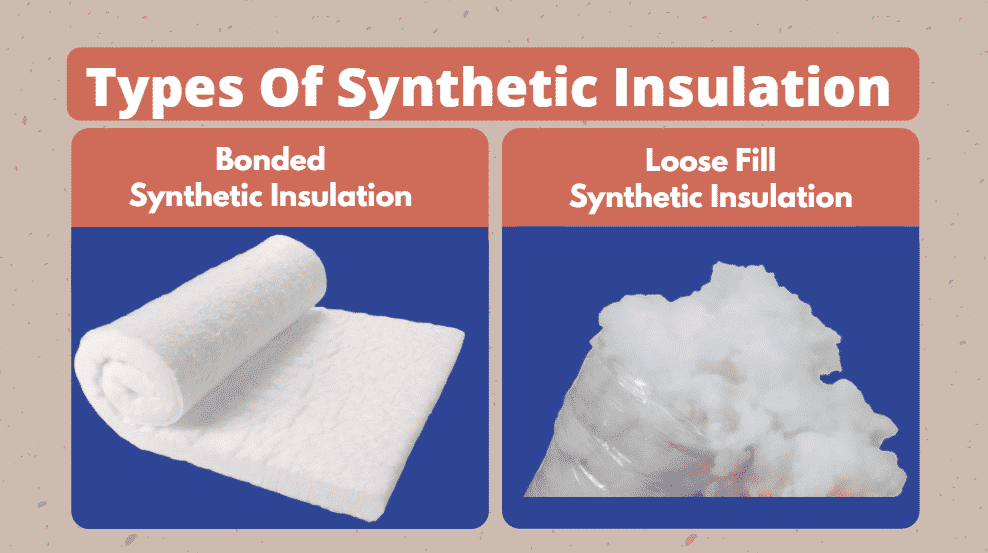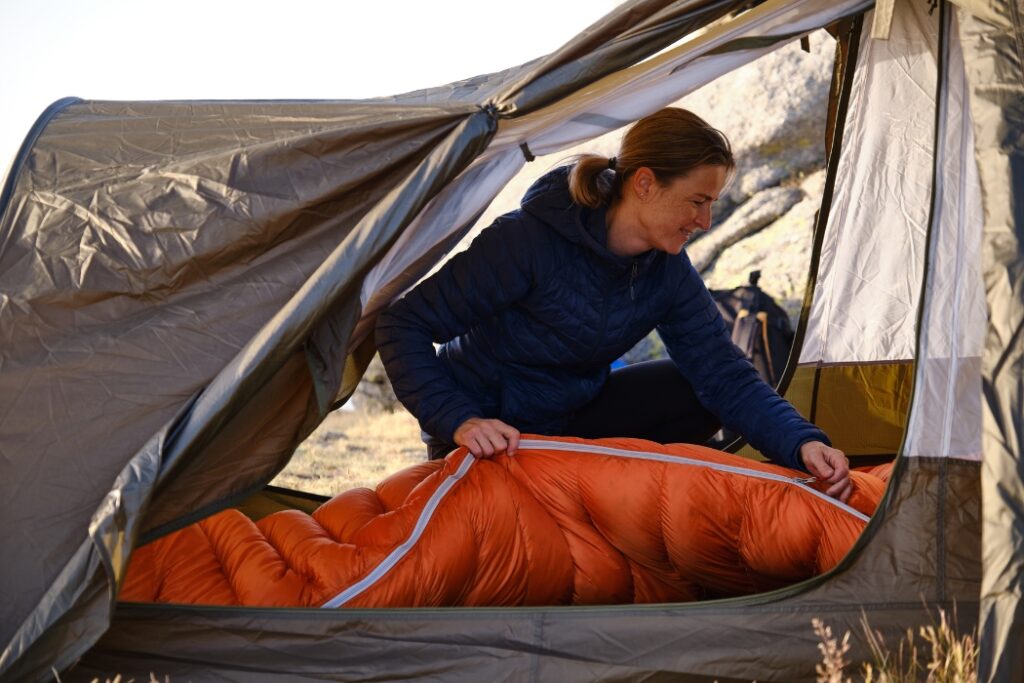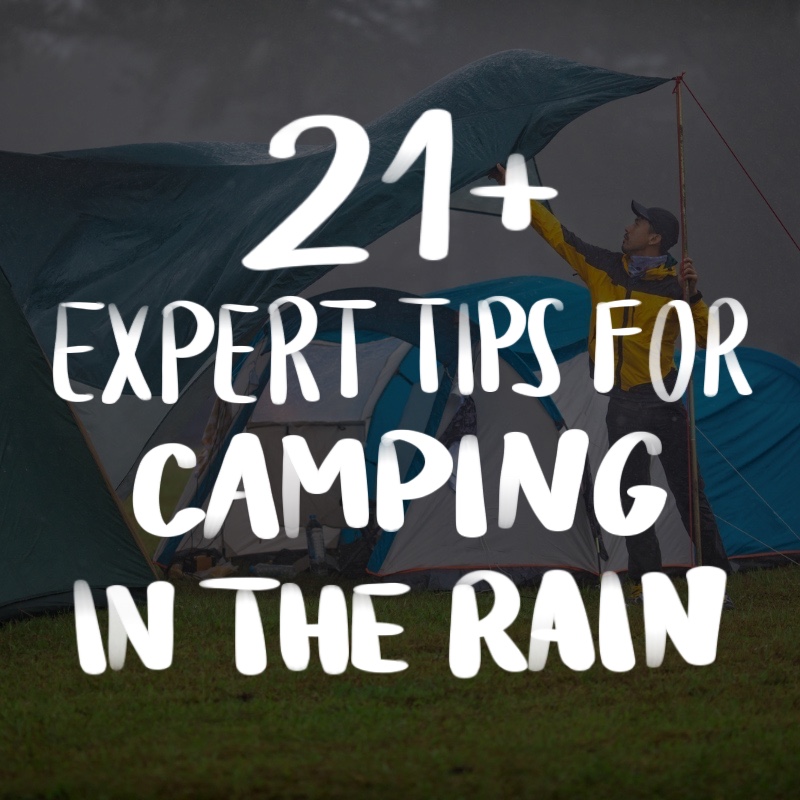
A good night’s sleep is essential to be rested and productive while camping, but only with a suitable sleeping bag.
There are two common types to consider: down vs. synthetic. Both have advantages and disadvantages, so it’s crucial to weigh the features of each before purchasing.
Is it the material, moisture resistance, durability, or price?
Let’s find out and decide wisely!
Table of Contents
Why is a Sleeping Bag Essential For a Camping Trip?

A sleeping bag is the essential outdoor gear you won’t miss when camping.
I emphasize this as a must, and you will understand why.
I was camping with friends in the wilderness. We thought we had all the camping gear for sleeping, such as tents and sleeping mats. Plus, we planned to keep warm by the campfire. However, no one thought about a sleeping bag.
I realized we would have trouble sleeping as night fell and it got colder. We were in a wooded area without shelter from the cold, and we had no adequate protection. We tried huddling around the fire to keep warm, but that only worked initially. After that, we all felt colder.
You can guess what happened next. We had to pack up and go back to get a sleeping bag. And we just wasted time.
After this, you will remember to bring this essential gear because you already know it will provide insulation and warmth while sleeping outdoors, protecting you from cold temperatures and humidity at night. It also provides comfort and mobility, so you can move while sleeping.
There are two main sleeping bag types: down and synthetic.
Read on to find out which sleeping bag material is suitable for warmer and colder conditions, as well as the criteria for determining the quality of this camping gear.
What is Down Fill?
Down fill is insulation made from ducks and geese’s soft coating. It is usually suitable for sleeping bags and jackets because of the feeling of light clothing and adequate warmth.
Since it’s made of nature’s finest insulators, the filling is sometimes called “natural insulation.” It’s also highly compressible, making it easier to pack and transport. Apart from a down bag, a down jacket is also comfortable for winter hiking. So, down-fill power is prominently present among camping equipment.
What Exactly is Fill Power?
Fill power is a measure of the quality of down in a product, in this case, a sleeping bag. It measures the “fluffiness” and weight of the down filling in cubic inches. How many cubic inches is enough to maintain that fluffiness? It’s just cubic inches per one ounce. The higher the filling power, the higher the insulation capacity of the down. The higher fill power indicates higher quality, and these insulations trap heat inside a sleeping bag.
Higher fill power also indicates that the down clusters are larger and more mature, meaning the down will be more durable and resilient.
Down Insulation

Down sleeping bag insulation is one of the best types of insulation. This soft duck and goose-down material are incredibly light, compressible, and durable.
The down insulation is also very breathable and allows air to flow through the sleeping bag, which helps regulate temperature rating and body heat.
Because it can keep you warm even in low temperatures, it is an integral part of the equipment in winter. Its down insulation can provide years of reliable warmth and comfort.
It’s usually expensive but worth the purchase because of its superior performance.
You need to pay attention to rainy weather, as it can lose some of its insulation when wet, so it’s essential to keep it dry.
Types of Down Insulation
The two most common types of down are duck and goose.
Duck Down
Duck down is a specific material made from the soft feathers of ducks and geese. It’s one of the most common types of insulation you’ll find in a sleeping bag and down jacket. The primary advantage of duck down is its high warmth-to-weight ratio. It is hypoallergenic, which makes it ideal for people with allergies.
Goose Down
Another type is goose down, which is highly valued due to its insulating properties and thermal efficiency. It has an extremely high warmth-to-weight ratio, meaning that a small amount of goose down can provide a large amount of warmth. Goose down is less available and, therefore, more expensive, but its superior insulating properties and luxurious feel make it well worth the price.
These two “feathered friends” can give you the comfort you want.
Synthetic Insulation

Synthetic insulations can also be suitable for camping.
Its artificial materials, such as polyester and nylon, keep sleeping bags warm even when wet. So synthetic insulation is a splendid choice if you’re a hiker, camper, or backpacker.
Synthetic insulation dries faster than down insulation and is more resistant to mold and bacteria.
It’s available in various weights and thicknesses, making it easy to find a sleeping bag that suits your needs.
Synthetic fill insulation is lightweight and highly compressible, meaning you can compress a synthetic bag to a much smaller size than a down bag, making it easier to store and transport.
Synthetic fill insulation is usually more breathable and resistant to mildew, fire and water, and other forms of deterioration than natural fill insulation.
Types of Synthetic Insulation

Synthetic fibers are waterproof and protect against wind, rain, and snow.
Here are some of the materials you can find in synthetic products:
Polyester
Polyester is a synthetic insulation material made of polyester fibers, and it’s a popular synthetic material used in sleeping bags and synthetic jackets with air pockets due to its lightweight and durable properties. It’s strong, temperature-resistant, and highly abrasion-resistant. These bags are also relatively easy to clean and maintain.
Primaloft
Primaloft is a synthetic material made of polyester, acrylic, and other fibers. It is designed to provide superior insulation, even in extreme conditions. Primaloft consists of tiny hollow fibers that can cause trapping heat and keep you warm even when wet. It’s also very breathable, allowing moisture to escape so you can be comfortable in any climate.
Thinsulate
It is a lightweight, breathable synthetic insulation material made of polyester and acrylic fiber designed to be worn directly against the skin in cold weather without feeling stuffy or overheated. It consists of millions of tiny fibers that trap air to keep the body warm and dry.
Polarguard
It is a type of synthetic fill made from polyester fibers. It is designed to provide superior warmth and comfort in cold weather conditions. The insulation is breathable, allowing moisture from sweat to escape while keeping body heat inside. It is water-resistant
Thermolite
ThermoLite is exceptionally light, water- and wind-resistant fabric that keeps you warm and dry in extreme conditions. Unlike others, it provides up to 10 times more warmth than other fabrics. It is perfect for outdoor activities such as camping, hiking, and snow sports. Similarly, the Termoloft material is made of polyester and Quallofil fibers but provides less warmth than Primaloft.
Climashield
Climashield is one of the advanced insulation materials available today that offers superior protection against extreme temperatures. It is made of great continuous fibers that make it highly durable. It is considered one of the most compressible, warmest, and softest insulation available today. Climashield is committed to the highest standards of quality and performance. It’s suitable for both sleeping bags and synthetic jackets.
Performance Considerations: Down vs Synthetic Sleeping Bag

Performance considerations between down and synthetic insulation are essential when deciding which type of sleeping bag to buy.
Imagine that this situation happened to you, as it happened to me on my camping trip.
Unfortunately, I hadn’t predicted rain, and my sleeping bag wasn’t waterproof. I risked my sleeping bag spoiling and also getting sick. I didn’t have enough heat and couldn’t wait for the night to pass because it was pretty cold. My sleeping bag obviously couldn’t last long in these conditions, so I put it away when I returned from camping.
So always keep these factors in mind before buying a sleeping bag.
Durability
Before you buy a sleeping bag, keep in mind its average lifespan.
Down sleeping bags are durable and can last many years if you care for them properly, even up to 10 years or more, with proper care and maintenance.
The down is resistant to tear, and the outside of the bag protects the insulation from dirt and moisture.
Synthetic bags can be durable and last for years with proper care. The average lifetime of a synthetic bag is 3-4 years.
Compressibility
Storage is one of the most important things to keep in mind when you go camping. So, consider the size of your sleeping bag and its compressibility to pack as much stuff as possible and take up as little space as possible. The goal is to have more room for all your things if you go camping for extended periods.
Down sleeping bags are highly compressible, making them ideal for backpacking and camping. The down’s airy structure helps trap heat, and the small package size makes it easy to carry and store.
Synthetic bags – Synthetic bag works the same way. It is pretty compressible as they come with sacks for more accessible storage and transport. Still, they can’t compare to down sleeping bags as they are bulkier and heavier.
Breathability
You must be comfortable while you sleep, so you must not ignore breathability as an essential factor when buying a sleeping bag.
Breathability means unrestricted airflow, creating a comfortable sleeping environment and preventing moisture from accumulating. Overheating and excessive sweating during warm weather may occur if you don’t have a breathable sleeping bag. Let’s see which one is more breathable.
Down sleeping bag – Down bag keeps body temperature and thus creates effective insulation, which also results in trapping air.
Synthetic sleeping bag – The synthetic bag is more breathable than down because they don’t trap as much heat inside the sleeping bag.
Look for sleeping bags made from synthetic insulation materials designed with breathable panels or baffles to improve airflow and moisture wicking.
Water Resistance
Moisture resistance is not equally present in both materials, so consider what time of year you want to go camping.
Down sleeping bag – Down sleeping bag insulation has a unique ability to repel outside moisture, making it a popular choice for wet weather gear. Each down product has a fill weight power. The higher the filling power, the better the insulation. Down’s natural ability to resist moisture comes from its structure. It is made of tiny continuous filaments that repel water droplets and keep warm air inside, thus creating an effective insulating material.
Synthetic sleeping bags – The advantage of synthetic insulation is that it will keep you warm if wet. If you plan to walk in heavy rain, I recommend this insulation. One more tip, you can use water-resistant coating for even more protection.
Cleaning and Maintenance
Cleaning and maintaining your sleeping bag is essential to maintain insulation and keep it clean while using it and for every subsequent camping trip.
Here are some tips for cleaning and maintaining your sleeping bag:
1. Clean regularly: It is essential to clean your sleeping bag after each use to remove dirt and sweat. Use a mild detergent and warm water to clean, then air dry.
2. Store properly: Store the sleeping bag in a dry and cool place. I recommend a mesh storage bag or a cotton pillowcase for storage.
3. Air it out: Be sure to air your sleeping bag after each use to keep it dry and prevent mold.
4. Wash it occasionally: Every few months, clean and wash your sleeping bag
5. Repair it: If you notice any damage to your sleeping bag, repair it immediately. In this case, use a light cloth
More tips: Most sleeping bags are machine washable using a front-load washer (or a top-load machine without an agitator).
If your washing machine is small, it will give your bag more room to roll over and thoroughly clean. Therefore, you can always wash it by hand somewhere outdoors where you have more space.
Also, you can use some liner every time you sleep in your sleeping bag to prevent excess sweat and dirt from building up, meaning you won’t have to wash as thoroughly.
When washing down bags, it is essential to use specialized down cleaners as it is susceptible.
If you have the conditions, gently wash synthetic bags in a sizeable front-loading machine with warm water and a gentle cycle.
Following these tips will ensure your sleeping bag is always clean and usable.
Price
The price difference may affect your last choice.
Down sleeping bags – Some of the most expensive on the market, but they are worth the investment if you consider their insulating qualities and compression. However, the price may vary depending on the down’s quality and the bag’s design.
Synthetic sleeping bags – A synthetic sleeping bag is usually cheaper than a sleeping bag, although prices vary depending on the type and quality of materials.
Hybrid Insulation in Sleeping Bags

You should consider hybrid insulating abilities if you want a sleeping bag that combines down and synthetic insulation.
So, what is the combination?
Down provides warmth and is light and compressible, while synthetic insulation provides hydrophobic properties and is less expensive.
Hybrid insulation sleeping bags are great if you want a sleeping bag that can provide the same warmth in various conditions. But still, you should think according to your needs.
Down or Synthetic Sleeping Bag?
Both down and synthetic insulation have their advantages and disadvantages. Down sleeping bags are lighter, more compressible, and provide a better warmth-to-weight ratio but are also more expensive.
Synthetic bags are more durable and easier to maintain but are heavier and bulkier and don’t provide as much insulation as sleeping bags.
Choosing a new sleeping bag depends mainly on your needs, budget, and preferences.
Remember these things and choose the ideal sleeping bag based on that. That’s the only way to have a restful sleep and a complete experience while camping.
Oh, and when you finally decide, it’s time to think about appropriate camping clothes and what to wear camping.
So what’s your favorite insulation material? Let’s chat in the comment below and share our experiences!
-
Aleksandar is a 29-year-old outdoor enthusiast with 10+ years of experience in camping and hiking. He found the Bored Adventurer because he loves spending his free time exploring the wilderness and sharing his experience with other fellow outdoor enthusiasts. Whether it’s the mountains or the seaside, summertime or winter, he jumps at every chance to escape the city and return to nature. His other interests include photography, digital marketing, and film.
View all posts





